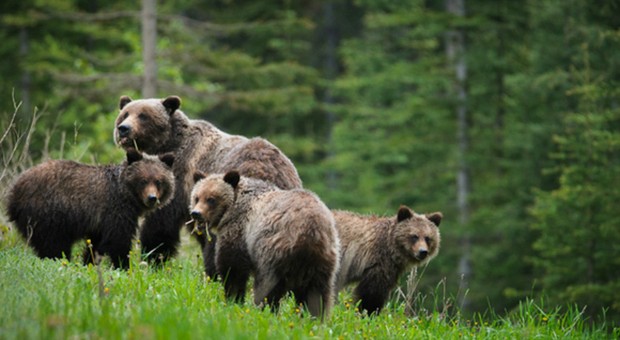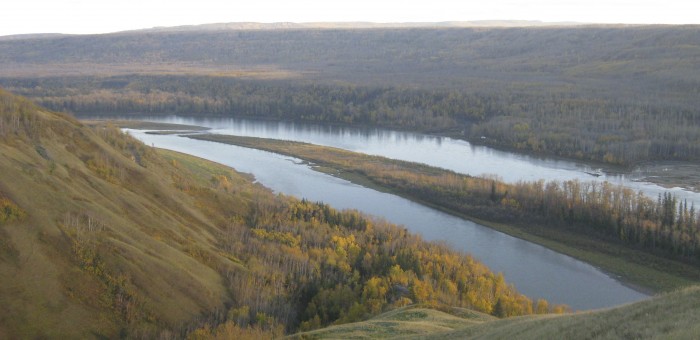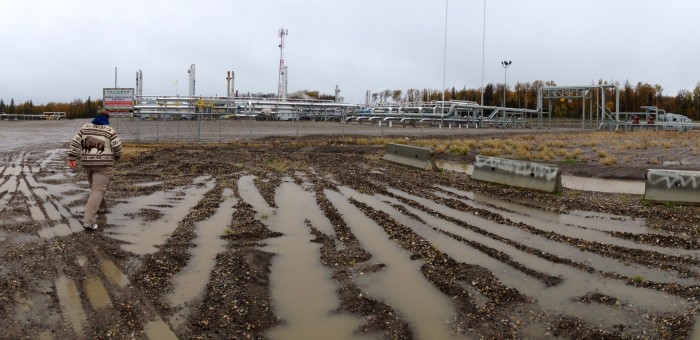Issues Blog
Before it’s too late: British Columbia needs a science- and ecosystem-based approach to wildlife management
At the time of European contact, wildlife were so abundant in British Columbia that early explorers marveled at the richness of the land.
“The country is so crowded with animals as to have the appearance in some places, of a stall yard,” Alexander Mackenzie wrote in his journal in 1793 while on the Peace River. He reported seeing herds of elk on the grasslands near Bear Flat, the irreplaceable habitat that will be drowned when the Site C dam is constructed.
Just over a decade earlier, on the West Coast of Vancouver Island, Captain James Cook noted an abundance of sea otters. He traded pelts into China, sparking a rush for furs that didn’t abate until sea otter populations crashed. It was the first example, in what would become known as British Columbia, of economic forces eradicating a species.
Early European settlers established markets not only for furs, but also for the hides and meat of wildlife. The uncontrolled harvesting that followed soon led to the extirpation of Roosevelt Elk on the Lower Mainland and Wood Bison in northern B.C.
By the late 1800’s wildlife losses were so widespread the public began demanding an end to the free-for-all. In 1859 the first ordinances “providing for the protection of game” were passed in B.C. In 1905 the government organized wildlife management, establishing the Department for the Protection of Game and Forests, although it didn’t get funding until 1908. The annual budget: $10,000.
In 1933 Aldo Leopold, an American conservationist and writer, published Game Management, a book that has been credited with creating the discipline of wildlife management through the application of scientific principles. Indeed, his work planted the seeds of what would eventually become the North American Model of Wildlife Conservation.
One of the key tenets of the Model, which is now widely applied across the continent, is that science – not the dictates of special interest groups – should guide wildlife policy.
I have dedicated my life to understanding our world and its problems through science, but have been surprised at how difficult it is to convince governments to consistently follow scientific reasoning. While the concept of science-based wildlife management has generally been endorsed in B.C. it has not always been applied.
There have been successes. Sea Otters are making a comeback, elk herds are increasing in southern B.C. and bison were successfully reintroduced to some areas in the north. But its selective use has lead to more disasters.
Many wildlife populations are in jeopardy today. Mountain caribou are facing extirpation, wild salmon – a foundation species – are in shocking decline, spotted owls are virtually extinct, and moose populations, which many rural families rely on for sustenance, are in trouble across the province.
What we find in almost all of these instances is that there has been inadequate science, particularly concerning cumulative impacts, and that an unacceptable loss of vital habitat has occurred. The management of wildlife, and the application, or not, of scientific principles, continues to stir great controversy and emotional debate in B.C. Understandably so.
Wildlife management conflicts in which species are pitted against one another are truly challenging, but I have always maintained that humans – elected representatives in particular – have a moral obligation to prevent endangered species from going extinct.
Often, extreme situations are created because government has failed to act. They are typically situations that – for a variety of industrial, social, or budgeting excuses – have been allowed to escalate far past a point of simpler intervention.
When you start rationalizing culling one species to protect another you also introduce an ethical element that needs to be considered alongside scientific findings. Let one – or both – of those species become threatened or endangered, however, and your situation becomes immensely worse.
Some say that humans should not interfere with nature, but sadly, intervention is sometimes necessary. Simply put, many ecosystems have been altered so drastically that we can no longer just stand by and let nature take its course.
If we don’t continue to intervene with the mountain caribou crisis we are currently facing, for example, it will not be long before the remaining herds in the South Selkirk and Peace regions are extirpated.
We cannot let that happen.
Predator control, hunting closures, and restrictions that stop industries from undertaking resource developments are all difficult matters for governments to deal with.
But things aren’t going to get easier. The management of wildlife is becoming increasingly complex and fraught with risk.
Habitat loss is mounting.
The human population is growing.
Roads and pipelines have been spreading into the farthest reaches of the province, and researchers have discovered how such developments increase predation, shift wildlife distribution, and impact abundance.
Wolves, for example, use road and pipeline clearings to get a good line of sight on caribou, expanding into new territory to more efficiently track down their prey. Increased road densities and human activity in wilderness areas elevates human-caused mortality of grizzly bears and reduced the number of bears in the area, scientists at the University of Alberta have recently found.
In a paper published this week in the journal Conservation Biology, scientists wrote about threats to biodiversity from cumulative human impacts in B.C., “one of North America’s last wildlife frontiers.”
“Land-use change is the largest proximate threat to biodiversity yet remains one of the most complex to manage,” they wrote. “For ecosystems, we found that bunchgrass, coastal Douglas fir, and ponderosa pine have been subjected to over 50% land-use conversion, and over 85% of their spatial extent has undergone either direct or estimated indirect impacts.”
Adding to all these other stressors now is climate change. The full implications aren’t yet clear, but we cannot situate our wildlife strategies in the past. Our environment is changing and will continue to do so.
We must be prudent and precautionary as we manage our changing landscape as the planet warms. The timing and abundance of food availability, for instance, will shift for some plants and animals. Species reliant on their stability will need space and additional resources if they are to adapt.
Another challenge that will become increasingly present in B.C. is that of invasive species. Not species introduced from a faraway land, though that will continue to be an issue, but species that have migrated from nearby landscapes as their own native environment ceases to meet their needs — climate refugees, in a sense.
As certain areas become warmer, for example, native species may start to move north. How will we manage those newcomers if they are having a negative impact on our own resident species? What if the invasive species are threatened or endangered in their home ecosystem?
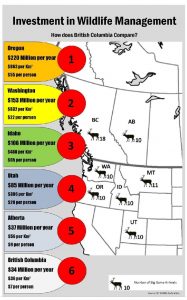 A few years ago, with concerns growing about how B.C. was managing wildlife in the face of growing pressures, the B.C. government assigned an MLA to do a comprehensive review of its policies.
A few years ago, with concerns growing about how B.C. was managing wildlife in the face of growing pressures, the B.C. government assigned an MLA to do a comprehensive review of its policies.
“There has never been a time in British Columbia’s history where balancing the cumulative impact of resource development and biodiversity has been so complex.” Liberal MLA Mike Morris wrote in his 2015 report, Getting the Balance Right: Improving Wildlife Habitat Management in British Columbia.
“There is an urgency and heightened concern amongst resident hunters, guide outfitters, trappers, the wildlife viewing industry and conservationists that the province is not acting quickly enough to address the decrease in wildlife populations and the degradation of wildlife habitat,” Morris wrote.
He called for more wildlife management staff and “better planning, better science and more timely and effective implementation of policies and programs.”
But the government never delivered.
“B.C. balks at changing law to protect wildlife and biodiversity” said The Vancouver Sun headline.
“The B.C. government will not be changing laws or considering hiring more staff as recommended in a report by one of its own MLAs on how to protect wildlife and biodiversity from the effects of resource industries,” the story said.
For far too long government has shortchanged wildlife management in B.C.
It’s fine for Ministers to say they support science-based decisions – but where is the science? Where are the field researchers? Where are the basic boots on the ground that are needed to keep a close watch on our wildlife populations and habitat?
The necessary funding just isn’t there.
B.C. ranks behind its neighbours in the northwest when it comes to investment in wildlife management. Alberta, Washington, Montana, Oregon, Idaho, Utah – all spend more on managing less.
The shameful underfunding of wildlife management has taken place under successive Liberal regimes. Now we have a new NDP government, but it has yet to show if it will fully embrace – and fund – science-based management.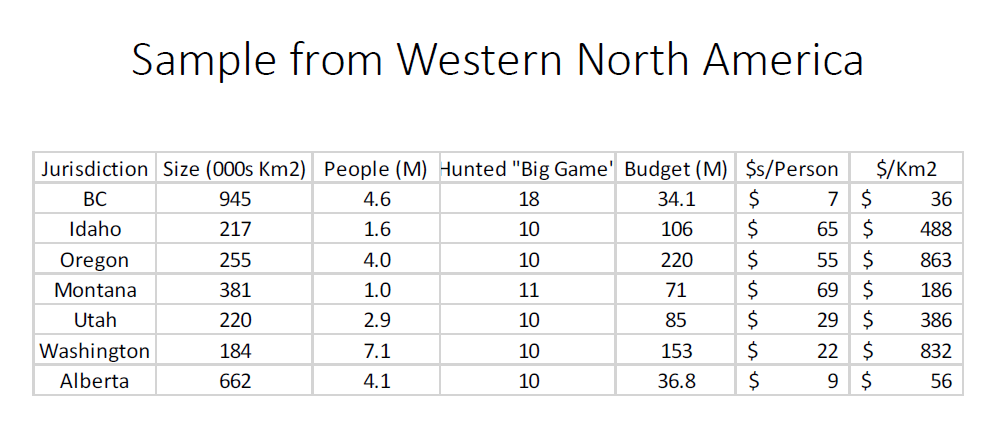
The problem is compounded because Ottawa too has been cutting back on wildlife science. In B.C. our wild salmon stocks are in decline, putting in jeopardy not only the economies of fishing communities, but also the health of killer whales, bears, eagles and other predators.
But a study published recently concluded, “there is inadequate information to determine the biological status of roughly one-half of all CUs ” in B.C.
CUs, or Conservation Units, are the system by which the federal government is supposed to monitor and manage our wild salmon stocks.
But Canada’s Wild Salmon Policy: an assessment of conservation progress in British Columbia reports that the government just basically gave up on collecting the data. We don’t know what is happening on the rivers because the government stopped keeping track.
“Our state of knowledge regarding salmon populations is eroding rapidly. Without increased support for escapement surveys and the transfer of knowledge to the next generation, the rich legacy of population data available for BC’s north and central coasts is at serious risk of becoming irrelevant for future assessments of management and conservation status,” states the study led by Simon Fraser University researchers Michael Price and John Reynolds.
B.C. is Canada’s most ecologically diverse province but if we are to maintain that rich biodiversity, we need to see a serious commitment to science-based, evidence-based wildlife management – and we need to have dedicated wildlife funding put in place, so managers have the budgets, and the staff, required to do the job.
As the Select Standing Committee on Finance and Government Services recommended in its Report on the Budget 2017 Consultations, license fees collected from natural resource users (hunters, anglers, ecotourists, etc.) should be directed into conservation and wildlife management services, rehabilitation, enforcement and education. In that, we must “prioritize and fund restoration and protection of endangered fresh and saltwater fish species and fisheries.”
Effective natural resource management is reliant on funding, science, and social support. We seem to have consensus on this within the B.C. government, but it needs to be put into action.
Prior to the election, I campaigned on establishing a Natural Resource Commissioner who could lead a Natural Resources Board responsible for establishing sustainable harvest and extraction levels and reporting on the state of B.C.’s environment and natural assets. The NRB, I proposed, would conduct cumulative impact assessments, and oversee the professional reliance model.
Since the election, the government has been working with us to improve the professional reliance model and B.C.’s environmental assessment process. We haven’t talked about creating a Natural Resource Commissioner position, but there is much we should to advance its values of scientific monitoring, reporting, and cumulative assessment.
Managing wildlife has always been difficult, but never more so than now, in the face of climate change. According to data released by scientists at NASA, 2017 was the second warmest year since record-keeping began in 1880, second only to 2016.
In the face of great challenges, it is clear to me that we need a comprehensive science- and ecosystem-based approach to wildlife management. We simply cannot continue to perpetuate the slow, methodical extirpation of native species in B.C.
Ecosystem-based management calls for natural resources, habitat, and species to be managed collectively, over a long time frame, rather than just looking at a single sector or single species.
Cumulative impacts are assessed – an approach which B.C. urgently must follow because of the sweep of industrial development now taking place in many sectors of the province.
Given the myriad challenges facing wildlife in our province, two of the best things we can do to protect biodiversity is to leave key habitat areas intact and fund environmental science. As the global climate warms and precipitation patterns shift, having a complete ecosystem within which animals and plants can try to adapt will be essential, and frankly it is the least we can do given the dire situation many species are in. Having an informed understanding of the changes taking place will help too.
It won’t be easy. But proactively protecting ecosystems – so we can all be resilient to the changes a warming climate will bring – is vital.
Welcoming clean tech investment from Western Economic Diversification to Alacrity
Western Economic Diversification Canada today announced a $787,115 investment in the Victoria-based Alacrity Foundation of B.C. to support the western clean technology sector. BC announced that it would supplement this funding with an additional $79,000.
We are absolutely thrilled with this investment in Alacrity. The foundation has played a crucial role in incubating, nurturing and growing innovative local tech companies through to maturation. They have a global reach with regional offices in China, France, India, Indonesia, Mexico, Singapore, Turkey, Wales and Ottawa, Ontario.
Below I reproduce a copy of our press release celebrating this investment.
Media Release
Weaver welcomes clean tech investment from Western Economic Diversification to Alacrity
For immediate release
January 23, 2018
VICTORIA, B.C. – Andrew Weaver, leader of the B.C. Green Party, welcomed an investment of over $787,115 to the Alacrity Foundation of B.C. to support the Western Clean technology sector.
“This is exactly the type of investment we need to be making to ensure that B.C. and Canada are global economic leaders,” said Weaver.
“The world is forging ahead with the transition to the low-carbon economy. Countries as diverse as China, to Germany, to Saudi Arabia are investing heavily in clean technology and alternative energy. With our highly educated workforce, outstanding postsecondary institutions and entrepreneurial spirit, B.C. is poised to be a leader in the clean tech revolution.
“Government has a significant role to play in championing this vision and setting the priorities for our province. Our party will continue to support investment and innovation in this sector so that we can make this vision a reality.”
-30-
Media contact
Jillian Oliver, Press Secretary
+1 778-650-0597 | jillian.oliver@leg.bc.ca
British Columbia ends the grizzly bear hunt
Today the BC Government announced a moratorium on the hunting of Grizzly bears in British Columbia. As you can see from our media release reproduced below, we are delighted with the BC NDP announcement.
Media Release
B.C. Green caucus responds to the end of the grizzly bear hunt
For immediate release
December 18th, 2017
VICTORIA, B.C. – “After years of work on this file, my colleagues and I are absolutely overjoyed this decision has finally been made. The results of the government’s consultation were clear and government has listened – we couldn’t be more thrilled,” said Adam Olsen, MLA for Saanich North and the Islands and B.C. Green Party spokesperson for the Ministry of Forests, Lands, Natural Resource Operations and Rural Development.
“A focus on protecting grizzlies has been a constant throughout my time at the legislature, and I am proud to have been able to help advance this issue,” said Andrew Weaver, MLA for Oak Bay-Gordon Head and Leader of the B.C. Green Party.
“Andrew has been a strong advocate for the long term wellbeing of grizzlies since his election in 2013,” said MLA Olsen. “He tabled the Wildlife Amendment Act multiple times and stood as a lone voice in the legislature against the B.C. Liberals who actively supported grizzly trophy hunting and the B.C. NDP who would not take a position. This legislation was intended to give the BC Liberal government a feasible path forward to protecting Grizzly Bears.
“Now we have a very different political landscape in B.C. and our office shifted its efforts accordingly,” said MLA Olsen, who became lead on this file after the May election. “The minority government and a governing agreement signed by the B.C. NDP and B.C. Greens have allowed us to take a stronger position and we commend the government’s bold announcement today.
“Ending the grizzly hunt is a momentous accomplishment, but there is still work to be done to protect this species. If we fail to also consider habitat and food supply – especially with climate change further threatening essential salmon and huckleberry stocks – conflicts with humans, roadkill rates, or poaching incidents, we will fail to protect grizzlies in the long term.
“We hope that this announcement will be followed with a comprehensive ecosystem based approach to wildlife management because we cannot continue to perpetuate the slow, methodical extirpation of native species in BC. We will celebrate progress along the way and work to ensure species like grizzly bears and wild pacific salmon have the resilient ecosystems they need to thrive into the future.
“This breakthrough would not have happened without the efforts of many – thank you and congratulations to everyone involved.”
-30-
Media contact
Sarah Miller, Acting Press Secretary
+1 778-650-0597 | sarah.miller@leg.bc.ca
Making the case for cancelling Site C in an open letter to government
Over the last few weeks Sonia Furstenau, Adam Olsen and I have tried to provide as much evidence as possible to make the case for cancelling the fiscally-reckless Site C megaproject. In fact, since I first raised the fiscal folly of moving forward with Site C in 2013, the case has become much, much stronger culminating in the British Columbia Utilities Commission report released on November 1, 2017.
In question period I’ve contrasted the escalating costs of Site C to the diminishing costs of renewables and noted the parallels with the controversial Muskrat Falls megaproject in Newfoundland and Labrador. I’ve pointed out that Site C was approved as a ratepayer funded subsidy to a non existent LNG industry. I’ve asked why the Columbia River Entitlement and distributed renewable projects have not been explored. And my BC Green colleagues have asked many more questions as well.
With the rising of the legislature last Thursday and ahead of an imminent decision regarding the fate of Site C, my caucus colleagues and I felt it was important to summarize our case against the project in an open letter that we sent to Premier Horgan. Below I reproduce a text of that letter.
Text of Open Letter
December 1, 2017
Premier John Horgan
Office of the Premier
Parliament Buildings, B.C. Legislature
Victoria, B.C.
V8V 1X4
cc: Hon. Michelle Mungall
Minister of Energy, Mines and Petroleum Resources
Dear Premier Horgan,
As we near cabinet’s decision on Site C, we write to you today to urge you to stop construction of the Site C dam.
Our Confidence and Supply Agreement committed government to sending Site C to the BC Utilities Commission (BCUC), BC’s independent regulatory agency, for an independent review of the project. In undertaking this review, the BCUC marshalled significant evidence and undertook an analysis of the implications of pursuing completion, suspension, and termination scenarios; the implications for ratepayers of different scenarios; and the potential for a portfolio of alternative sources of energy to meet demand.
The resulting report was comprehensive and provided a strong, evidence-based rationale for cancelling Site C. This rationale is founded in a number of key findings presented in the report, including:
- Site C is already over budget, and is beset by considerable risks of further costly overruns and delays;
- An alternative portfolio can meet future demand requirements, at the same or lower prices than Site C.
The BC Green Caucus believes that the findings of the report more than make the case that the best course of action for government is to cancel the project, remediate the land and begin the work of developing a 21st century energy system based on options presented in the alternative portfolio.
This argument is laid out in greater detail below.
Costs and risks of Site C
The estimated cost of Site C has escalated throughout its lifespan. Just last month, when the river diversion deadline was missed, the cost increased again from $8.3 to $8.9 billion, accompanying a year-long delay to the construction schedule.
It was therefore unsurprising to see the BCUC Panel determine that Site C will be behind schedule and substantially over budget. In the BCUC Panel’s words, “given the nature of this type of project and what has occurred to date, total costs for the project may be in excess of $10 billion and there are significant risks that could lead to further budget overruns”. The Panel found that these remaining risks include unresolved tension cracks and disputes with contractors. As such, the Panel found that it is unlikely that Site C will be completed on schedule by 2024, and even that construction costs could escalate even further beyond $10 billion.
This cost escalation is significant, and will have substantial impacts on British Columbia ratepayers. Given that we are only 2 years into what is supposed to be a 9-year construction project, we are gravely concerned about the impact on British Columbians of further expected delays and cost overruns.
As cabinet makes its decision, we hope they will also heed the lessons learned from another large-scale dam under construction, Muskrat Falls, in Newfoundland and Labrador. When the Muskrat Falls Project was sanctioned, it was estimated to cost $6.2 billion plus financing. The costs have since ballooned to more than $12 billion. The impact of this cost increase on rates in Newfoundland is profound. Nalcor Hydro now estimates that costs from the Muskrat Falls dam will result in rates almost doubling.
The lessons from this project are significant and relevant. Just last week the Newfoundland and Labrador government initiated a public inquiry into what happened with Muskrat Falls. Richard LeBlanc, the provincial Supreme Court judge leading the independent inquiry, has said “while we cannot undo the past we can learn from it”. While it may have been too late for their government to cancel their project, it is not too late for BC. We hope this government heeds his words and chooses a different path.
The potential of alternatives to meet demand
As part of its review, the BCUC was also mandated to analyze the ability of an alternative portfolio of commercially feasible projects and demand-side initiatives to provide similar energy benefits to Site C, including their potential to meet demand and their costs to ratepayers.
The Panel found that not only could an alternative portfolio of conservation, wind energy, and geothermal energy meet demand and provide similar benefits to ratepayers as Site C, but that it could do so with an equal or lower unit energy cost.
In addition to recognizing the current viability of alternative energy in BC, the Panel found that disruptive trends in technology pose one of the most significant risks to continuing with Site C. Evidence from around the world substantiates the Panel’s warning about technological trends. Prices for wind, solar, and
geothermal energy have plummeted year by year. The pace and scope of technological advance have exceeded even the most optimistic predictions.
Instead of locking ourselves into the path of the Site C Dam, we should seize this opportunity to build clean, distributed power that puts us on the cutting edge of innovation, and provides jobs and benefits to local communities.
In addition, though beyond the scope of the BCUC review, it is critically important that government also consider the impacts that this project has on First Nations, particularly in light of our collective commitment to implementing UNDRIP. Government must also consider the project’s impact on the environment of the Peace River valley. Through pursuing an alternative energy portfolio instead of Site C, BC can partner with First Nations, industry and local communities to build clean, distributed power across BC. These alternatives will employ more people than Site C and provide local jobs and benefits to local communities.
In the face of these developments, it would be irresponsible for government to continue down the path of Site C. We do not require Site C to meet our future energy needs – alternative sources of energy are more than able to meet demand, and they will enable us to adapt to changing needs, as they provide flexible sources of energy. In contrast, Site C locks us into an energy future that could impose significant burdens on future ratepayers, and we would be forced to sell any surplus power at a loss.
Final considerations
Laid out in front of this government is a choice. The previous government chose to forgo evidence and due diligence, and pushed forward irresponsibly with a project that it is clear should never have been started. What the BCUC report tells us is that it is not too late to correct this mistake.
However, the choice facing your government is not simply about which option will save ratepayers the most money. It’s a choice about what type of province we want to build. All around the world jurisdictions are embracing a modern, 21st century approach to energy policy. Pursuing this future would see the creation of a distributed, integrated power grid where the economic and employment benefits are shared by communities throughout the province.
Site C puts this future further out of reach, doubling down on the energy projects of the last century and undermining our ability to embrace the future.
We hope, as cabinet considers this decision, that they properly weigh this information contained within the BCUC report. Your government made the right decision in agreeing to commission an independent review before we crossed the point of no return. You need now to be guided by the evidence that this report puts forward.
This government has an opportunity to undo the mistakes of the last administration and chart a new, modern path for energy policy in BC. We hope you will seize this opportunity.
Sincerely,
Andrew Weaver
Leader, B.C. Green Party
MLA, Oak Bay-Gordon head
Sonia Furstenau
MLA, Cowichan Valley
Adam Olsen
MLA, Saanich North & the Islands
The Letter
Media Release
B.C. Greens make the case for cancelling Site C in open letter to government
For immediate release
December 1, 2017
VICTORIA, B.C. – B.C. Green MLAs Andrew Weaver, Sonia Furstenau and Adam Olsen sent an open letter today to Premier Horgan and Minister of Energy, Mines and Petroleum Resources Michelle Mungall making the case for cancelling Site C.
The B.C. Greens have been opposed to Site C since costs begun to escalate well past its initial budget, while the global cost of alternative energy has continued to fall.
The letter is attached.
-30-
Media contact
Sarah Miller, Acting Press Secretary
+1 778-650-0597 | sarah.miller@leg.bc.ca
Exploring the outrageous taxpayer subsidies for natural gas exploration
On Thursday this week I rose in the Legislature to ask the Minister of Energy, Mines and Petroleum Resources once more about the outrageous taxpayer subsidies to companies that drill for gas in northeastern BC. I initially raised this issue two weeks ago during budget estimates for the Ministry. As I noted then, the province makes virtually no money on natural gas royalties. And we have an accumulated $3.2 billion dollar tax credit subsidy on the books for this industry.
Below I reproduce the video and text of our exchange.
Video of Exchange
Question
A. Weaver: I must say it’s a bit rich. It’s a bit rich to listen to members opposite, the Leader of the Official Opposition stand up and talk about failed promises when I sat and listened for four years to the promise of unicorns in all of our backyards from LNG. On that topic, every year the B.C. government…
Interjections.
Mr. Speaker: Members, we shall hear the question.
A. Weaver: …doles out hundreds of millions of dollars to oil and gas companies to subsidize horizontal drilling in the northeast of our province. The companies earn these credits by drilling qualified wells, and when the wells start to produce gas, the companies apply the credits to reduce or even eliminate provincial royalties that they normally pay on this public resource.
In recent years, the participating companies have amassed credits faster than they can spend them. The balance in their deep-drilling account has increased from $752 million in 2012 to an accumulated $3.2 billion today. Not only are we not getting paid for this public resource, we are literally paying companies to take it from us.
My question is to the Minister of Energy, Mines and Petroleum Resources. How can the minister justify continuing the deep-well royalty program when it is not needed by gas companies and it is such a staggering waste of taxpayer money?
Answer
Hon. M. Mungall: Thank you to the member for the question on what is a very important issue.
Let me start by saying that British Columbians want this government to ensure that projects are providing good family-supporting jobs, but they also want to make sure that projects are meeting high environmental standards — absolutely. They want to make sure that British Columbians are also getting a fair rate of return.
Last year the province received $145 million in royalty revenue from natural gas development. This money obviously goes to help support the services that British Columbians rely on every day.
We also want to ensure that, as I said, we’re meeting the highest standard of environmental protection. That’s why this government has announced that it will be moving forward with a hydraulic fracturing scientific review panel. That panel is going to be getting started in the new year, and we’ll have more details following January.
Most importantly, this government is committed to ensuring that all British Columbians benefit from safe and sustainable development in this province, and that’s what we’re going to be doing.
Supplementary Question
Mr. Speaker: Leader of the Third Party on a supplemental.
A. Weaver: It was so boisterous I couldn’t hear you acknowledging my standing here.
The deep-well royalty credit program was designed to enable the provincial government to share the costs of drilling in B.C.’s deep gas basins when it was a so-called risk-based industry. It’s not anymore. Horizontal fracturing is no longer a new technology. It’s become an industry norm.
In 2009 and again in 2014, the B.C. Liberals relaxed the requirements for deep-well credits so they could pay companies more money to drill. In the eight years prior to the 2009 changes, B.C. collected an average of $1.3 billion per year in natural gas royalties. In the eight years since, B.C. collected an average of $307 million per year. Last year, the minister told us, we collected a mere $145 million.
Measured as a share of the value of oil and gas production in B.C., royalties collected by government…
Interjections.
Mr. Speaker: Members.
A. Weaver: …has fallen from 44 percent in 2008 to just 4 percent last year. Our government is literally giving away our natural resource and paying oil and gas companies to extract it.
My question to the hon. Minister of Energy Mines and Petroleum Resources is this: how can your government continue with this giveaway when there is such an urgent need in our society to transition to a low-carbon economy?
Answer
Hon. M. Mungall: To speak to this particular program, I just want to make sure that the member knows that many of the credits that he speaks of will actually likely never be used as older wells are closed. Just as an example, one well earned a million dollars worth of credits, but it’s been shut for ten years. It’s not going to reopen, so it will not actually be realizing those credits.
There are quite a few other examples exactly like this. I would be happy to set up a briefing for the member so that he could get to the full details of this issue that, I’m very glad, he’s quite concerned about. Question period doesn’t allow the time to go over all the details.
Again, I will say that this government is committed to ensuring that British Columbians get a fair rate of return for their resources, that they have good family-supporting jobs and that we are protecting our environment.




